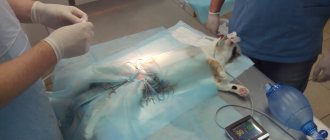A cat on a leash walking down the street with its owner brings a smile to your face these days. However, it does provide an opportunity to think about the benefits and risks of this practice for the cat. People often refer to cats as dogs, but a cat is not a dog and its needs are not the same as a dog's. Many cat owners wonder whether they need to walk their pets?
What is a harness and why is it needed?
There are quite a few types of leashes; in addition, instead of them, another device called a harness can be used to walk a cat. Its difference from a leash is that its design allows you to avoid the use of a collar. This has a better effect on the physical health of the pet.
A cat leash makes walking with your pet easier
Harnesses come in different shapes:
- H-shaped;
- Y-shaped;
- V-shaped;
- eight;
- vest.
The essence of the device is that the leash is attached to straps that wrap around the cat’s body, or to a special overalls. This distributes the stress of pulling on the leash differently than when using a regular collar, and there is less risk for your pet to suffer physical injury.
Why are cat leashes necessary?
How to put a harness on a cat: options with different types
Not all cat owners know that their pets can be walked like dogs. Cats are usually kept as exclusively domestic animals, especially if the family lives in a metropolis, where there is no opportunity to let the cat go for an independent walk, as in the village.
However, these animals also love walks. They are not a necessary part of caring for a pet, but they can significantly diversify and brighten up a cat’s life, as well as add more opportunities for physical activity.
A cat on a leash can run and play safely during a walk.
To prevent the cat from running away while walking and to stay close to the owner, a cat leash is used. Walking a cat without a leash is also possible, but if it gets scared or something attracts its attention, the owner will have no control over the pet, and this can either lead to the animal getting lost or to more serious consequences if events occur, for example, near the roadway.
Important! In addition to walks, leashes and harnesses are also useful during trips to the veterinarian and various trips if owners do not have a special carrier.
Differences between cats and dogs
If you have a sociable animal that accepts most new things, then you can certainly try walking with your pet. But if you have a cat that hides under the bed even at the slightest change in the home environment, experts don't recommend adding stress to the cat.
Cats readily accept indoor play as their only place to relax, and their social tendencies vary greatly: meeting unfamiliar cats is often stressful for the animal rather than an opportunity to play and socialize with others. Walking means moving in an unknown environment without the usual smells. There is also a risk of the cat being injured or suddenly frightened when encountering unfamiliar dogs.
When should you not use a harness?
Dog chain: kennel jerk collars
Although it is a convenient device for both the pet and its owner, using a collar with a leash for cats is not always possible. It is not recommended to use it in the following situations:
- For an older cat who is not harness-trained, trying to walk her can be very stressful, which can negatively impact her health. If the animal has never gone for walks in its life, it is not recommended to start them in old age.
- For a small kitten, you should very carefully select a suitable harness, since its body is actively growing and developing.
- Difficulties in learning to wear a harness can occur in overly fearful or aggressive animals, since due to stress they can accidentally harm themselves.
- If the cat is pregnant, has recently undergone surgery, or has any physiological defects, wearing a harness may be contraindicated, or you will have to carefully choose the model.
Walking rules
In order for a walk with a cat to go properly and not discourage the animal from going out into the fresh air, you must adhere to the following recommendations:
- Avoid noisy places. Any loud sound of a passing car or a child's scream can greatly frighten your pet, and therefore it is undesirable to walk on the street near the roadway or playground. It is better to carry your pet in your arms or in a carrier to the nearest park or any quiet place.
- Avoid contact with strangers. It is better not to allow stray animals near your pet to avoid fights or to avoid infection.
- The cat's safety comes first. When an unfamiliar and, in addition, aggressive dog runs towards you, it is not recommended to keep the cat on a leash. It is better to pick him up in your arms or give him the opportunity to climb the nearest tree. This way the purr will feel safe and will not be stressed.
- It's better to eat at home. It is important to ensure that the cat does not pick up food in its mouth on the street to avoid infection or poisoning.
Types of cat harnesses
A cat has a belly button: do cats have it, why not?
Choosing the shape of a harness mainly comes down to understanding which model is most comfortable for your pet. Descriptions of some of the main types are given below.
Important! You may have to try several different models before you can find the right one.
H-harness
A leash for cats can be H-shaped. This is one of the most popular types of harnesses: two straps are connected by two straps on the sides, one of the straps goes around the cat's neck, the second goes around the chest behind the front paws.
Figure-of-eight harness
This harness consists of two straps fastened in a figure eight shape. Assembling and putting it on your cat can be difficult, and this model is also not suitable for overly active animals, as they can get tangled in the straps. However, for calm cats, the “eight” will be a good option.
Harness vest
The pet can also be dressed in cat overalls. This is the safest model of harnesses, giving scope for many interesting decorative solutions. The vest usually has clasps on the animal's back and can be made from a variety of materials and decorated in a variety of ways.
A vest for a cat is the safest model
Abandoned Angel
Any city dweller, and even more so a summer resident, has probably thought about whether it is worth allowing a pet to spend time outside the home.
Having studied materials from foreign Internet sites, we can say that recently even people living in private houses with their own territory are increasingly inclined to not let their pet wander around the neighborhood without permission.
The overwhelming number of city residents also prefer to keep animals exclusively in the apartment, not allowing them to walk on their own. And this is absolutely correct.
This begs the question: why?
To do this, it’s worth thinking about what your cat can expect outside of her home.
A short list of the dangers that await an animal on the street:
1) Cars. Many believe that in rural areas, where cars pass relatively rarely, there is no need to worry about our four-legged friends in this regard. Alas, this is not always the case. There is a high probability that relaxation and loss of vigilance will cost the life of a cat who is unwary on the road. 2) Diseases. Even if the cat is vaccinated, there is no 100% guarantee. Not only fleas, ringworm, worms, etc., but also dangerous diseases such as rabies can be transmitted from a pet to its owner. 3) Poisoning. 4) Clashes with other animals (dogs, wild cats). They threaten with injury, including death, and often cause serious illness. 5) Cruelty on the part of man. Pets are often trusting and do not think that people can pose a real threat to them. This naivety plays into the hands of the flayers. 6) Falling from a height, getting stuck in cracks and similar situations. Collars with which a cat runs the risk of getting tightly caught on something become extremely dangerous on the street. 7) Possibility of getting lost. A sudden loud sound can greatly frighten your pet and cause it to run away in an unknown direction. If the case happens in a dacha, even a fence will not stop a fugitive running in fear. But finding him later will be very difficult...  Uncontrolled sexual intercourse. This is a great chance to become infected and bring unwanted offspring, thus making your “contribution” to the increase in the number of homeless animals. Here we would like to remind you once again that we encourage you to neuter your pets!
Uncontrolled sexual intercourse. This is a great chance to become infected and bring unwanted offspring, thus making your “contribution” to the increase in the number of homeless animals. Here we would like to remind you once again that we encourage you to neuter your pets!
These are just the most basic points that we would like to draw your attention to.
The attentive reader will also notice that not only external factors as such can lead to trouble, but also the cat’s own habits often lead to sad consequences. “Curiosity killed the cat” - this English proverb very accurately characterizes what can happen to a reckless explorer of the surrounding area.
Of course, it is difficult for an ordinary person to imagine how one can constantly stay indoors and never go outside. But is walking outside really necessary for your pet? Let's try to figure it out.
First, let's answer the question of why many people think that their pet wants to be outside the house.
Firstly, people judge by themselves. But we must not forget that a cat is a completely different creature and what is good for you and me is not necessarily so for her.
Secondly, the owners are worried whether their pet has enough physical activity and talk about “natural” behavior, that is, the opportunity to hunt, etc. In this regard, we can say the following: a modern cat is a pet. She has existed side by side with a person for a long time, so he, especially in the present time, is quite capable of providing her with a comfortable and interesting life without walking. Read more about this below.
Thirdly, the picture of a pet sitting on the window, watching with longing and interest what is happening on the other side of the glass, brings to mind thoughts of captivity. “Interest” is the key word in this case. As mentioned above, cats are curious. It is not surprising that they like to watch, they are attracted by unfamiliar smells and sounds coming from the windows (don’t forget about the screens on the windows! Details in the article CATS AND WINDOWS). However, in reality, with the exception of uncastrated animals driven by the reproductive instinct, pets have no need to go outside.
Everything a cat really needs can be obtained in her home.
This is true. After all, there is nothing difficult in diversifying your pet’s leisure time! Toys will serve as a hunting purpose and will make you move more; a scratching post will be an excellent solution for keeping claws in shape; competent organization of space in the apartment will help the cat realize its desire to climb higher and hide in its own hole. Don't forget to give your pet a soft bed on the windowsill, where he can bask in the sun and watch everything that happens indoors and outdoors. And to replenish the supply of vitamins, we recommend purchasing a special herb at the pet store - cats love this delicacy!
If you suddenly decide to take a walk with your pet, remember the following: - only vaccinated animals can be walked - kittens should not leave the house - if your pet is not happy about the walk (afraid, meows, etc.), do not force it - You can only take your cat out for a walk using a harness - keep the leash on at all times in case of an unforeseen situation. It is important that the harness does not dig into the throat, so you should not direct the movement in any direction, but rather follow the animal yourself - for a walk, use a quiet place with a lawn or soft ground. You should bring your pet there in a carrier, putting a harness on it in advance.
As you can see, compared to the comfort of home, much more difficulties arise in order to ensure the safe stay of a cat on the street. So ask yourself again – is it worth it? Comfort, tranquility, a caring owner - that’s basically all your pet needs. And you can do all this, without worrying about the life and health of your cat.
Tell friends:
How to choose the right size and type of harness
If the harness is not made independently, but purchased in a store, it is very important to choose the right not only the type of design, but also its size. Belts that are too narrow can damage the animal's fur and skin, while belts that are too wide can restrict movement. The material of manufacture is also important: it must be soft and durable for the greatest comfort of the animal.
To understand that the selected size is suitable for the cat, you should put a harness on it and check whether you can stick two fingers between it and the animal’s back. If not, the size of the product is too small and will embarrass your pet during a long walk.
Important! The best option would be a harness, the size of which can be adjusted.
Let's consider other options
Most often, leashes are used as protective devices to prevent an animal from escaping when you are going somewhere, for example, to a veterinary examination. In such circumstances, leash training your cat for safety is a good idea in case your cat gets loose. Some people teach cats to walk on grass, which is necessary for the animal to cleanse its stomach of hair. In this case, it is necessary for the cat to get used to the street, because then even a short walk in the countryside on the grass will not cause anxiety and stress in the animal.
How to make a harness with your own hands
A cat collar for walking can be made by hand. It can be crocheted, knitted or embroidered from fabric - the method depends on the preferences and skills of the manufacturer.
Before starting work, it is necessary to take measurements. A measuring tape is suitable for this. The following measurements should be taken:
- Cat's neck circumference. You will need to leave an additional 1-2 cm for allowances.
- Chest circumference. It is measured behind the animal's front paws at the level of the shoulder blades. Here you will also need to add a couple of centimeters so that the finished product does not fit too tightly to the body.
- Distance from the collar to the chest strap. It is measured along the line of the back.
Taking measurements for a harness is a simple procedure
It is imperative to choose a durable material for the product, and also make sure that the parts are firmly connected to each other. If the product is not created in the form of a vest, but in the form of interconnected straps, they can be fastened using special fasteners or rings.
Advice! The ring for attaching a rope or leash should be located on the back side.
The finished product can be decorated with decorative details, but it is important to ensure that the harness does not turn out to be too heavy. If possible, avoid using parts that are too small and ensure that they are securely fastened, otherwise the animal may try to chew them off.
How to put on different types of harnesses
How exactly to put a harness on a cat depends on its shape and the parts that are included in the kit, be it individual straps or full-fledged clothing items, such as a vest.
First of all, a smaller strap or collar is placed around the neck, then the front paws are inserted through the second strap. If your cat is wearing a harness, it is important to carefully fasten the straps so as not to pull them too tight.
Important! When adjusting the tightness of the tightened belts, remember that two fingers should be placed between the animal’s back and the harness.
The leash itself is attached immediately before going outside; the mount for it is always located on the back in the area of the shoulder blades.
Is it possible to walk a cat
This question cannot be answered directly. Inexperienced owners can only be advised to compare the life of a pet cat with their own. Both a person and a cat, theoretically, can spend their entire lives within the four walls of an apartment, feeling not bad at all. But you don’t want to sit in a stuffy room all the time, do you?
Only by walking and playing on the street can an animal feel true freedom and the charm of life, which will immediately sparkle with new colors. The pet will rejoice and will delight the owner with its desire to chase insects and lie on the grass, basking in the rays of the warm sun. Regular walks will strengthen the cat's respiratory and nervous system and make it more resilient.
Many people will wonder whether it is possible to walk a cat in winter. It is clear that in winter it is very cold outside, so you need to act carefully, gradually accustoming the animal to low temperatures. Again, everything will depend on the wishes and well-being of the pet itself. For some lovers of home warmth, a short stay on the balcony will be enough.
How to train a cat to wear a leash
The sooner work begins on accustoming your pet to a cat collar for walking, the easier the process will be. The most appropriate age to start leash training and take a kitten outside is between three months and one year. During this period, the animal’s immunity has already been formed, so there is less risk of catching some disease on the street. However, if you plan to walk your cat frequently, it is recommended to take care of the appropriate vaccinations.
Teaching a kitten to a leash
For older cats, getting used to a new accessory will be more difficult. Accustoming will have to be done step by step and this process may not be quick.
- The first step is to introduce the leash to the cat. It should be left in places where the animal frequents, for example, near a favorite sleeping spot. This way the cat will get used to the presence of a new unfamiliar object. This may take time, up to several days.
- The next step is to try putting the harness on the cat. If the animal behaves aggressively or is too frightened, it is recommended to put the harness aside and try to put it on the cat again after a while.
- When the pet gets used to the belts or vest, you can attach a leash and lead the cat around the apartment.
It is recommended to go outside for the first time in a quiet place where there will not be a large number of people and other animals, as well as cars. The cat will need time to get used to the new environment, so if she does not want to go for a walk and remains sitting still, you should not force her to move.
When the animal gets used to the leash, the process of walking can bring a lot of positive emotions to both the pet and its owner.
How to walk a cat for the first time
When planning to walk cats on a leash, be prepared for an ambiguous reaction from your pets: the animal may be very frightened, or it may be so carried away by the walk that it wants to run away from you. Therefore, check the strength of the leash in advance, then attach it to the harness and hit the road, taking the puppy in your arms or placing it in a carrier.
Don’t put the cat down on the ground right away, let her look around, sniff and get used to it. If your pet is very frightened, it is better to accustom it to walking on the ground gradually, taking it outside for a few minutes every morning. Do not put off outdoor trips for too long: the animal will experience stress like the first time, forgetting about previous impressions.










